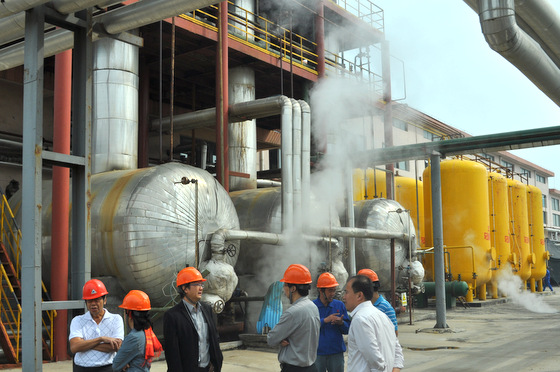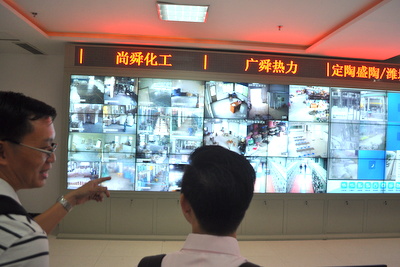 @ China Sunsine's plant in Weifang. NextInsight file photo.
@ China Sunsine's plant in Weifang. NextInsight file photo.
 Bank of CCTV cameras monitor operations at China Sunsine's plants. NextInsight file photo. Financial health of Sunsine
Bank of CCTV cameras monitor operations at China Sunsine's plants. NextInsight file photo. Financial health of Sunsine
Besides increasing accelerator capacity from 24,000 tonnes to 87,000 tonnes, Sunsine also ventured into the production of insoluble sulfur (IS) and anti-oxidants.
The first 10,000-tonne IS production line was installed in Shanxian. When demand picked up, a new 18-hectare base was set up in Dingtao with an initial capacity of 10,000 tonnes, making Sunsine China's number one IS producer. There is space for another 20,000 tonnes.
Sunsine produces three types of anti-oxidants (TMQ, 5PPD and 6PPD). The combined capacity is 45,000 tonnes comprising 10,000 tonnes for TMQ, 5,000 tonnes for 5PPD, 30,000 tonnes for 6PPD.
The cost of capacity building for all chemicals amounted to RMB 550m.
Sunsine has also invested RMB 150m in a fuel-efficient steam supply system in Shanxian.
Besides RMB 700m on capital expenditure, higher working capital amounting to RMB 600m was required to support inventories and trade receivables as sales rose from RMB 475m before IPO to RMB 2,077m in 2014.
Moreover, RMB 200m was paid out as dividends in the recent past seven years and another RMB 26m was spent on share buyback.
All in, RMB 1,528m was spent after the IPO in 2007 that raised only RMB 260m.
Yet, it had RMB 456m in cash and near-cash as at 30 June this year against bank loans of RMB 212m. And throughout its expansion trail, Sunsine has lowered its risk of loan default by staying highly liquid.
This was possible because of Sunsine's dominance in the rubber accelerator sector. Expansion moves were carefully timed to keep spare capacity low to generate enough cash.
Among the top three rubber chemical producers in China, Sunsine is the only one that makes all three rubber chemicals (accelerators, IS and 6PPD).
Jiangsu Sinorgchem specialises in 6PPD. Kemai's focus is on accelerators as TMQ is a low-grade anti-oxidant with thin margin.
On the world stage, Flexsys produces only IS after giving up on accelerators.
Sunsine's entry into the 6PPD market may take some time to bear fruit. Tyre companies want to be assured of the efficacy of this newly-introduced product. Sunsine does not reveal sales revenues of each type of anti-oxidants. But there is reason to believe that 6PPD is becoming more popular judging by the rising combined sales (see table).
| Sales volume of anti-oxidants (tonnes) | |
| 2011 | 2,061 |
| 2012 | 5,183 (6PPD sales started ) |
| 2013 | 12,281 |
| 2014 | 19,903 |
6PPD will be less of a drag on profit margins when the 30,000-tonne capacity is better utilised.
IS may turn out to be a big winner. Sunsine has revealed that with persistent R&D, its IS is not much inferior to that produced by Flexsys, world's top IS producer.
The high unit fixed cost of the Dingtao IS base (designed for 30,000 tonnes but is producing less than 10,000 now) will drop as sales expand.
|
Summary Demand for rubber chemicals, which are needed to make rubber products, is set to rise. |






